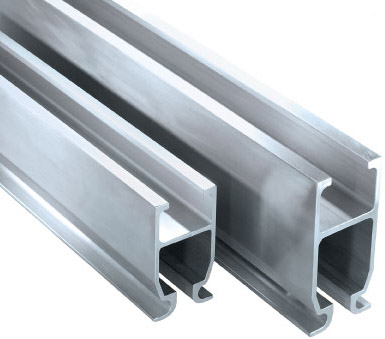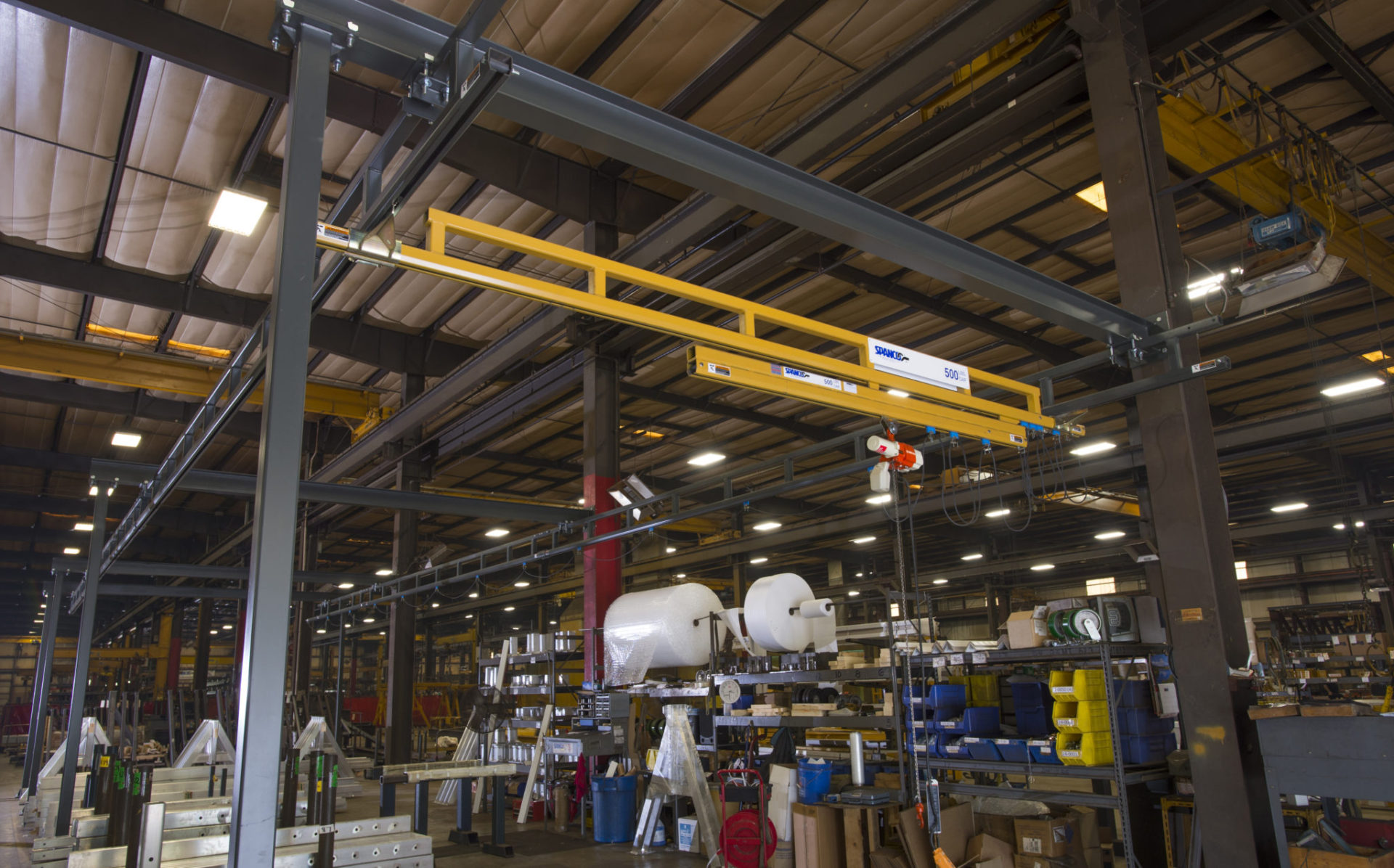
Enclosed Track VS Patented Track
Jul 2, 2019
Enclosed Track and Patented Track Comparison
Many modern overhead bridge cranes with capacities from 250 pounds to several tons use one of two types of track for hoist trolley-travel: enclosed track or patented track. Enclosed track is a type of rail that is formed into a hollow tube with an opening on the bottom. The profile of enclosed track is typically a square or rectangle that tapers toward the opening. The hoist trolley is inserted into the track so that the wheels of the trolley rest on the inside of the rail.
Patented track looks similar to a standard I-beam, but it has several key differences. Patented track has a wide upper flange connected to a narrower lower flange with a vertical steel segment. This design gives patented track a profile that is similar to inverted railroad track. The hoist trolley wraps around the lower flange so that one set of wheels rests on the top of the flange on either side of the vertical segment. These differences make patented track suited to overhead bridge crane systems, but they also make it more expensive than I-beam track.
Both enclosed track and patented track are suited for particular applications. Each option has certain strengths and weaknesses that make it ideal for one type of application but not for another. Let’s look at the features of both kinds of track and some of the applications that work best with each kind.
 As we mentioned in the first paragraph, enclosed track is enclosed around the hoist trolley that travels inside it. Unlike other types of track, enclosed track extends the life of the trolley by protecting it from environmental factors. The trolley can’t be damaged from external impact because the sides of the track surround it completely. If the track is equipped with a seal, it can also keep virtually all dirt and debris out of the track and away from the trolley.
As we mentioned in the first paragraph, enclosed track is enclosed around the hoist trolley that travels inside it. Unlike other types of track, enclosed track extends the life of the trolley by protecting it from environmental factors. The trolley can’t be damaged from external impact because the sides of the track surround it completely. If the track is equipped with a seal, it can also keep virtually all dirt and debris out of the track and away from the trolley.
The trolley protection offered by enclosed track allows trolleys to be designed to more precise tolerances. Enclosed track trolleys have exceptionally low rolling resistance, so they can usually be operated manually without motorization. However, depending on capacity and span, some enclosed track systems may need to be motorized or can be motorized if the customer chooses.
Enclosed track systems are typically less expensive than patented track systems. Many enclosed track systems don’t require specialized foundations beyond standard reinforced concrete floors, so they can help keep costs down by utilizing the existing floor and foundation. They are also easier and quicker to install and reconfigure if needs change after the system is installed. Enclosed track systems have a smaller footprint, so they can be installed and expanded without interfering with existing equipment.
Typically, maximum capacities for enclosed track systems are around 4,000 pounds. To achieve maximum capacities above 4,000 pounds, heavier systems like standard I-beam, box girder, or patented track systems are worth consideration.
Patented Track
Patented track is similar in shape to an I-beam, but it is not quite the same. I-beams have top and bottom flanges of the same width, but patented track has a narrower lower flange, which allows the wheels of a trolley to sit closer together and closer to the center of the beam. I-beams also have flanges that slope toward the center of the beam, but patented track uses flat flanges that allow trolley wheels to be flat instead of tapered.
Patented track rails are made specifically for overhead cranes, whereas I-beams and wide-flange beams are structural members that are typically intended for construction. Due to looser tolerances, these beams can vary in the width and thickness of the flanges, which can lead to greater wear for crane hoist trolleys. The angled shape of I-beams can also cause additional wear on trolleys unless the angle of the trolley wheels matches the I-beam exactly. Because patented track has flat flanges and wheels, the angle of the beam does not have to be considered.
Patented track might seem better suited for overhead bridge cranes than structural members, but what about enclosed track? Compared to enclosed track, patented track is typically much more expensive. The track itself has a greater initial cost, and systems normally require additional foundational support beyond standard reinforced concrete floors, which can raise costs even further. Additionally, despite having lower rolling resistance than I-beam or wide-flange beams, patented track has a greater rolling resistance than enclosed track and almost always requires motorization.
The greatest advantage patented track has over enclosed track is that it is able to achieve greater maximum capacities than enclosed track. While enclosed track systems are typically limited to around 4,000-pound capacities, patented track can often be rated for capacities up to 40 tons.
Enclosed or Patented Track
Both enclosed track and patented track systems have advantages and disadvantages. Enclosed track takes up less space, but it is limited to lower capacity ratings. Patented track can handle heavier loads, but it is more expensive than enclosed track or beam tracks. In most cases, the decision comes down to the application. If the maximum load required by the application is 4,000 pounds or less, enclosed track is most likely the best solution. If the application requires the ability to lift more than 4,000 pounds, patented track or beam track might be a good option.
If you have an application that requires a capacity of 4,000 pounds or less, Spanco Enclosed Track Workstation Bridge Cranes and Monorails might be the right option for you. Spanco Workstation Cranes are available in either freestanding or ceiling-mounted configurations with capacities from 250 to 4,000 pounds. Freestanding systems mount directly to your facility’s existing flooring, and the support columns take up minimal space. Ceiling-mounted systems use hangers to attach to your facility’s ceiling support structures, leaving floorspace available for personnel and equipment.
For applications that require capacities up to 4,000 pounds, Spanco Workstation Cranes provide effective, ergonomic material handling solutions. Higher capacity applications may be better suited for other types of cranes. Spanco Jib Cranes and Gantry Cranes are available with capacities up to a maximum of 15 tons for heavier lifting applications. In the end, knowing the needs of your application and benefits and limitations of different types of cranes is the best way to get the best product for any job.
Categories
Share this post
Contact us
Looking for the perfect fall protection equipment? Let us help!

